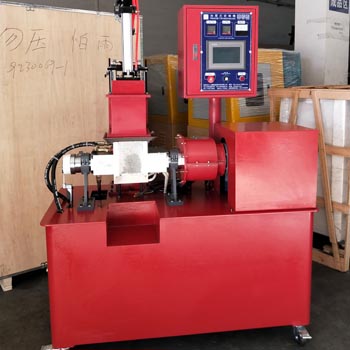Lab ceramic kneaders are essential mixing equipment used in the processing of ceramic powders, espercially when uniform blending and binder dispersion ,the lab ceramic kneader equipment are very critical in the production .
In advanced ceramic production, the quality of your final product comes from the mixing stage. Whether you’re working in research and development or preparing small-batch production, a lab ceramic kneader machine offers significant advantages when processing ceramic powders with binders or additives.
These lab kneading machines for ceramic are widely used in R&D labs and pilot production lines in ceramics, electronics, and materials science industries. But how exactly does a lab kneader work for ceramic powder?
In this article , Let’s explore its principles, benefits, and application process.
1. How Does A Lab Kneader for Ceramic Works?
A lab kneader for ceramic usually consists of two sigma-shaped blades which rotate within a closed mixing chamber at different speeds, which generate force shearing, folding, and compressing the material.
For ceramic powder applications, the high viscosity ceramic kneader machine mixes the dry powder with a liquid or viscous binder , then create a homogeneous paste or dough-like material.
The laboratory kneader machine works in batch mode, which allow precise control over mixing time, speed , temperature, and vacuum if the kneader is equipped. This function is very ideal to handle and process high-viscosity mixtures which are required in ceramic processing industries.
2. Why Use a Lab Kneader for Ceramic Powder?
Ceramic powder must be mixed uniformly with other organic materials ,like plasticizers or binders such as PVA, PEG, so that create a consistent texture and also improve forming behavior. A lab kneader for ceramic can do much as follows:
* Homogeneous mixing: Ensures even binder distribution throughout the powder.
* De-aeration: Optional vacuum systems remove entrapped air, reducing defects in green parts.
* Temperature control: Jacketed chambers allow heating or cooling to manage binder behavior.
* Controlled shear: Prevents material degradation while ensuring optimal dispersion.
3. The Mixing Process that a Lab Kneader in Ceramic Powder
Step 1: Preparation
The required amount of ceramic powder and binder (wet or dry) is measured and prepared for batch mixing.
Step 2: Loading
Both powder and binder are loaded into the kneader’s mixing chamber. The kneader can handle materials with poor flowability thanks to the powerful sigma blades.
Step 3: Kneading Process
As the blades rotate, they compress and fold the mixture, applying high shear to break up agglomerates and ensure even mixing.
Step 4: Temperature/Vacuum Control (Optional)
Depending on the material, the kneader may apply heat to reduce binder viscosity or vacuum to eliminate air bubbles.
Step 5: Discharge
Once the desired consistency is reached, the mixed ceramic dough is discharged manually or via tilting or bottom valve.
Benefits A Lab Kneader for Ceramic Bring:
1. Superior Mixing of High-Viscosity Materials
When ceramic powder mixtures are mixed with binders like PVA, PEG, or wax will form high-viscosity dough-like materials. That is where a lab ceramic kneader work ,it is specifically designed to handle these thick and sticky pastes because it adopt sigma blades which can create a strong shear force, compressing and folding the material thoroughly.
2. Precise Binder Dispersion
The key reason that high quality ceramic can be formed because of even binder distribution. Since uneven binder coating would cause cracking, voids, or density variation in green parts. The lab ceramic kneader ensures each ceramic particle is coated uniformly by constantly stretching and folding the mixture.
3. Vacuum Equippment
Many lab ceramic kneaders can be tailored vaccum design, which is very important to remove trapped air from the mixture in ceramic processing ,thus prevent defects like pinholes or bubbles in sintered components.
4. Temperature Control for Heating & Cooling
As some binder require heating ,then it can fluid in case of being harden. Lab ceramic kneader machine can be equipped with jacketed mixing chambers for heating or cooling, which allow operators to maintain optimal process temperatures.
5. Small-Batch Flexibility & Process Control
Laboratory kneader for ceramic material are ideal for small-volume or pilot-scale production. You can set and adjust the mixing time,speed, temperature, vacuum ,so that develop, test, or optimize formulations.
7. Cleaner and Safer Mixing Process
Compared to other high-speed mixers or blenders, a Laboratory kneader for ceramic formulation testing offers a sealed mixing environment, minimizing dust, contamination, and operator exposure to fine ceramic particles.
Thus , using a lab kneader for ceramic powder ensures precise, repeatable mixing of powders and binders, it is critical to achieving strong, uniform green bodies and high-performance ceramics.
Therefore , no matter you are in material development or quality testing for laboratory use, a lab kneaders are indispensable tools in modern ceramic processing labs.







